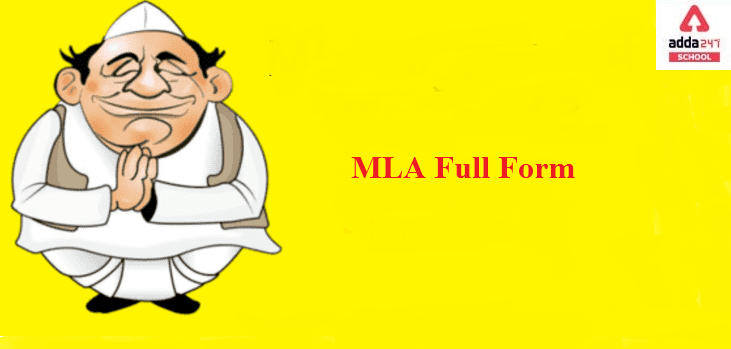Table of Contents
MLA stands for Member of the Legislative Assembly. In the Indian system of government, a Member of the Legislative Assembly is a representative chosen by the people of an electoral district, also known as a constituency, to the legislature of the State government.
MLA Full Form
The voters elect a Member of the Legislative Assembly (MLA)as one representative to the Legislative Assembly from each constituency. For more than six months, a minister must be a member of the Legislative Assembly. If a Chief Minister or minister is not a member of the Legislative Assembly, he must become an MLA within six months to keep his office. The Speaker of the Legislative Assembly can only be a member of the Legislative Assembly.
MLA Full Form in Government
According to Article 158 of the Indian Constitution, the Governor cannot be a member of the Legislature or Parliament. The Legislative Assembly has a maximum of 500 members. The number must also be at least 60. Small states have a provision for having an even smaller number of members in the Legislative Assembly, based on population or size.
The adult franchise is used to elect all members of the Legislative Assembly MLAs. A single constituency elects one member. The 104th Constitutional Amendment Act, 2019, eliminated the Anglo-Indian reserved seats in India’s Parliament and state legislatures in January 2020.
MLA Full Form in Hindi
विधायक का पूर्ण रूप विधान सभा के सदस्य के लिए है।
सरकार की भारतीय प्रणाली में, विधान सभा का सदस्य राज्य सरकार की विधायिका के लिए एक चुनावी जिले के लोगों द्वारा चुना गया प्रतिनिधि होता है, जिसे एक निर्वाचन क्षेत्र के रूप में भी जाना जाता है। मतदाता प्रत्येक निर्वाचन क्षेत्र से विधान सभा के लिए एक प्रतिनिधि का चुनाव करते हैं। छह महीने से अधिक के लिए, एक मंत्री को विधान सभा का सदस्य होना चाहिए। यदि कोई मुख्यमंत्री या मंत्री विधान सभा का सदस्य नहीं है, तो उसे अपना पद बनाए रखने के लिए छह महीने के भीतर विधायक बनना होगा। विधान सभा का अध्यक्ष केवल विधान सभा का सदस्य हो सकता है।
भारतीय संविधान के अनुच्छेद 158 के अनुसार, राज्यपाल विधानमंडल या संसद का सदस्य नहीं हो सकता है। विधान सभा में अधिकतम 500 सदस्य होते हैं। संख्या भी कम से कम 60 होनी चाहिए। छोटे राज्यों में जनसंख्या या आकार के आधार पर विधान सभा में सदस्यों की संख्या और भी कम रखने का प्रावधान है। विधान सभा के सभी सदस्यों का चुनाव करने के लिए वयस्क मताधिकार का प्रयोग किया जाता है। एक निर्वाचन क्षेत्र एक सदस्य का चुनाव करता है। 104 वें संविधान संशोधन अधिनियम, 2019 ने जनवरी 2020 में भारत की संसद और राज्य विधानसभाओं में एंग्लो-इंडियन आरक्षित सीटों को समाप्त कर दिया।
Eligibility of an MLA
The following are the requirements for becoming a member of the Legislative Assembly:
- The individual must be an Indian citizen.
- A member of the Legislative Assembly must be at least 25 years old, and a member of the Legislative Council must be at least 30 years old (as per Article 173 of the Indian Constitution).
- No one can become a member of a state’s Legislative Assembly or Legislative Council unless they are a registered voter in one of the state’s constituencies. Those who are unable to become members of Parliament are likewise unable to serve in the state legislature.
- The person should not be convicted of any crime or sentenced to more than two years in prison.
Duties and Power of an MLA
- The most crucial duty is that of making laws; and legislation on all issues that Parliament cannot address.
- Education, marriage and divorce, forests, and the protection of wild animals and birds are some of the themes on which both Parliament and states can pass legislation.
- Only the Legislative Assembly can introduce bills. Within 14 days of receiving the measure, the Legislative Council can either pass it or propose modifications to it.
- The Assembly may or may not embrace these modifications.
Aside from creating laws, the state legislature has the electoral ability to elect the President of India. - The state legislatures are involved in the process of amending the Constitution, and Parliament can alter certain provisions of the Constitution with the assent of half of the state legislatures.
MLA Full Form: Important Facts
- The Legislative Assembly of any Indian state serves a five-year tenure. However, under some circumstances, it may be dissolved sooner. The Governor has the authority to dissolve the Legislative Assembly at the request of the Chief Minister. This occurs when the Chief Minister commands the support of a majority of the people. During an emergency, the Legislative Assembly’s term may be extended. It cannot, however, last longer than six months at a time.
- The Legislative Council is the state’s upper chamber, and it is a permanent body. Members of the Legislative Council are appointed for a six-year term depending on the strength of each party in the lower house and by state gubernatorial nomination.
- Every two years, a third of the members of the House leave. The lower house of a state assembly can dissolve the upper house if it adopts a special legislation bill stating that the upper house should be dissolved. It must also be confirmed by both chambers of parliament before being signed into law by the president.
- With a six-year term, only Andhra Pradesh, Bihar, Karnataka, Maharashtra, Telangana, and Uttar Pradesh have upper houses. The upper chamber has been removed in all other states using the above-mentioned procedure, as it produces unnecessary complications, expenditures, and issues.
What is the Salary of an MLA?
One crore to four crore rupees are given to the MLA as an ‘MLA fund’ for his/her constituency. Here we have listed the funds the MLAs got for the development of their constituency state wise.
| Salary of an MLA | |
| State | Salary and Fund of MLA ( in Rs.) |
| 1. Telangana | 2.5 lacs |
| 2. Delhi | 2.10 lacs |
| 3. Uttar Pradesh | 1.87 lacs |
| 4. Maharashtra | 1.70 lacs |
| 5. Jammu & Kashmir | 1.60 lacs |
| 6. Uttrakhand | 1.60 lacs |
| 7. Andhra Pradesh | 1.30 lacs |
| 8. Himachal Pradesh | 1.25 lacs |
| 9. Rajasthan | 1.25 lacs |
| 10. Goa | 1.17 lacs |
| 11. Haryana | 1.15 lacs |
| 12. Punjab | 1.14 lacs |
| 13. Jharkhand | 1.11 lacs |
| 14. Madhya Pradesh | 1.10 lacs |
| 15. Chhattisgarh | 1.10 lacs |
| 16. Bihar | 1.14 lacs |
| 17. West Bengal | 1.13 lacs |
| 18. Tamil Nadu | 1.05 lacs |
| 19. Karnataka | 98 thousand |
| 20. Sikkim | 86.5 thousand |
| 21. Kerala | 70 thousand |
| 22. Gujarat | 65 thousand |
| 23. Odisha | 62 thousand |
| 24. Meghalaya | 59 thousand |
| 25. Puducherry | 50 thousand |
| 26. Arunachal Pradesh | 49 thousand |
| 27. Mizoram | 47 thousand |
| 28. Assam | 42 thousand |
| 29. Manipur | 37 thousand |
| 30. Nagaland | 36 thousand |
| 31. Tripura | 34 thousand |
| Other Important Full Form | |
| CBSE Full Form | ICSE Full Form |
| CEO Full Form | SOP Full Form |
| AM PM Full Form | ACP Full Form |
| PO Full Form | OTT Full Form |
| OTG Full Form | CS Full Form |



 CUET PG Result 2025 Soon @exams.nta.ac.i...
CUET PG Result 2025 Soon @exams.nta.ac.i...
 NEET Admit Card 2025 Release Date, How t...
NEET Admit Card 2025 Release Date, How t...
 CUET UG 2025 Vs CUET UG 2024, Check Majo...
CUET UG 2025 Vs CUET UG 2024, Check Majo...










